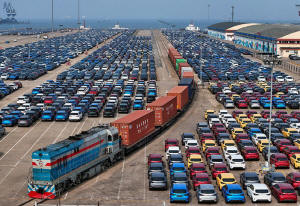China's exports to US sink, offset by trade with other economies, as US
tariffs hit global trade
[May 09, 2025] By
ELAINE KURTENBACH
China’s exports to the United States tumbled in April while its trade
with other economies surged, suggesting that President Donald Trump's
tariffs offensive is hastening a shakeup in global supply chains.
Total exports from China rose 8.1% last month from a year earlier, much
faster than the 2% pace most economists had been expecting. That was
much slower than the 12.4% year-on-year increase in March. Imports fell
0.2% in April from the year before.
Shipments to the U.S. sank 21% in dollar terms as Trump’s tariffs on
most Chinese exports rose to as high as 145%. With Chinese tariffs on
U.S. goods at 125%, business between the two biggest economies has grown
increasingly uncertain.
China's imports from the U.S. dropped more than 13% from a year earlier,
while its politically sensitive trade surplus with the United States was
nearly $20.5 billion in April, down from about $27.2 billion a year
earlier.
In the first four months of the year, China’s exports to the United
States fell 2.5% from a year earlier, while imports from the U.S. fell
4.7%.
A potential break in the tariffs stalemate could come as soon as this
weekend. Treasury Secretary Scott Bessent and other senior trade
officials are due to meet with Chinese officials in Geneva on Saturday.
But Beijing and Washington are at odds over a raft of issues, including
colliding strategic interests that will may impede progress in the
talks.
Some of the punitive tariffs, including Beijing’s retaliatory 125%
tariffs on U.S. exports, could be rolled back, but a full reversal is
unlikely, Zichun Huang of Capital Economics said in a report.

“This means China’s exports to the U.S. are set for further declines
over the coming months, not all of which will be offset by increased
trade with other countries. We still expect export growth to turn
negative later this year,” Huang said.
Whatever the outcome of those discussions, the rapid increase in Chinese
exports to other countries reflects a restructuring that began years ago
but has gained momentum as Trump has raised barriers to exporting to the
U.S.
Global manufacturers have been looking for alternatives to a near total
reliance on manufacturing in China after disruptions from the COVID-19
pandemic highlighted the need for more diverse options.
[to top of second column] |

A cargo train moves past new cars waiting for shipment in a port, in
Yantai in east China's Shandong province on Wednesday, May 7, 2025.
(Chinatopix via AP)
 The need for more versatile supply
chains grew more apparent as Trump hiked tariffs on Chinese exports
during his first term in office. Most of those remained during
former President Joe Biden's term.
Exports to the United States accounted for about a tenth of China’s
total exports in April and the U.S. is still China's largest
single-country market. But the European Union and Southeast Asia are
larger regional export markets.
Trade with a broader grouping, the 15-nation Regional Comprehensive
Economic Partnership (RCEP), which does not include the United
States, is still bigger. And exports to countries participating in
China's “Belt and Road Initiative,” a vast network of
Beijing-supported infrastructure projects, are bigger still.
In the first four months of the year, exports to the 10-nation
Association of Southeast Asian Nations rose 11.5% from a year
earlier, and those to Latin America also climbed 11.5%. Shipments to
India jumped nearly 16% by value, and exports to Africa surged 15%.
Some of the fastest growth was in Asia, reflecting moves by Chinese
and other manufacturers to diversify their supply chains outside of
the Chinese mainland. Most notable were exports to Vietnam, which
jumped 18% year-on-year. Exports to Thailand were up 20%.
Back in China, preliminary data have shown a sharp decline in
shipping and other trade activity. Earlier this week, Beijing
announced a barrage of measures meant to counter the impact of the
trade war on its economy, which was already struggling to regain
momentum after the pandemic and a lengthy downturn in its housing
sector.
___
Associated Press researcher Yu Bing in Beijing contributed.
All contents © copyright 2025 Associated Press. All rights reserved
 |